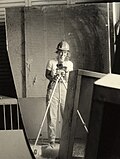| DescripciónMural-Ariel-Rios-Rockwell-Kent-1.jpg |
English: Photograph of mural "Mail Service in the Tropics" by Rockwell Kent at the Ariel Rios Federal Building, Washington, D.C.
- Date: 1937; dimensions: 7' x 13' 6".
- Photographed as part of an assignment for the General Services Administration.
- Title, date and keywords from information provided by the photographer.
- Credit line: Photographs in the Carol M. Highsmith Archive, Library of Congress, Prints and Photographs Division.
- Gift; Carol M. Highsmith; 2009; (DLC/PP-2009:083).
- Forms part of: Photographs in the Carol M. Highsmith Archive.
Mural information from the General Services Administration:
- Depicting mail delivery to the island of Puerto Rico, Mail Service in the Tropics is notable for its rhythmic figures and bold colors. However, when the mural was unveiled, public response did not focus on the technical merits of the mural, but on the text of the letter that the postman delivers to the four women. Relying on his familiarity with Alaskan culture, Kent painted text in the little-known Kuskokwim dialect, creating a fictional message sent from Alaska to Puerto Rico. Translated, it reads: "To the people of Puerto Rico, our friends! Go ahead, let us change chiefs. That alone can make us equal and free." The implication of revolutionary sentiments angered groups of both American and Alaskan viewers. In Puerto Rico, some viewers objected to the inclusion of only dark-skinned figures. These negative reactions led to an extended public debate that ultimately was left unresolved (see "Revolution and Race," below).
Revolution and Race
Rockwell Kent made his first trip to Puerto Rico in July of 1936, while conducting research for Mail Service in the Tropics. There, he encountered and was distressed by scenes of great poverty, especially among those of African descent. At this time, the Nationalist Party repeatedly clashed with political leaders, including the U.S.-appointed governor, culminating in the March 1937 Ponce Massacre, during which Puerto Rican police killed approximately twenty and wounded over 100 peaceful Nationalist parade-goers. Due to his political and humanitarian sympathies with the Puerto Rican people, Kent chose to depict the dark skinned Puerto Ricans that he encountered during his visit, and to embed in his mural a message of political solidarity.
In September of 1937, newspaper reporter Ruby Black, a friend of Kent's who had worked in Puerto Rico, published a translation of the text, which was confirmed by another friend of Kent's, Arctic explorer and ethnologist Vilhjalmur Stefansson. Heated reactions ensued from individuals who interpreted Kent's inscription as inciting revolution. The New York Times called the murals "insurrectionary propaganda," albeit ineffective; Rep. Anthony J. Dimond of Alaska wrote to Postmaster General James A. Farley, objecting to the misrepresentation of Alaskan sentiments: "The natives of the Kuskokwim, like other residents of Alaska, are loyal and devoted citizens of the United States, and they have no more intention of making war against the Government of the United States than you and I have."
Stefansson responded directly to Dimond, noting that the text did not call for violent revolution, merely a change of power. Black also defended the text, writing, "if a great country like America could not tolerate on her walls a mild expression in favor of liberty, Puerto Ricans were all the more right in wishing to have their independence." Kent, for his part, argued that the aspiration communicated in the letter, the "burning desire for independence," was an essentially American one.
Nonetheless, Kent offered to replace the text with: "May you persevere and win that freedom and equality in which lies the promise of happiness." W. E. Reynolds, director of procurement for the Section of Fine Arts, countered with: "To commemorate the far-flung front of the United States Postal Service." But Kent refused this alteration, insisting on retaining a message of liberty and independence.
Puerto Rican officials, while remaining quiet on the Kuskokwim text, objected to Kent's inclusion of only dark-skinned men, women, and children. Santiago Iglesias, resident commissioner of Puerto Rico, wrote that the picture did not represent the country or its culture, referring to it as "perverse propaganda against our country;" Rafael MartÃnez Nadal, president of the Puerto Rican Senate, called the mural an insult due to its depiction of "a bunch of half-naked African bushmen;" the mayor of Ponce, Puerto Rico, described the subjects as "unkempt and uncultured." In response to this barrage of racist criticisms, Kent offered, provocatively, to revise the panel free of charge to include portraits of members of the Puerto Rican Senate, including Nadal himself if he would agree to model for Kent.
In August of 1938, Puerto Rican governor Blanton Winship requested $3,000 from the Puerto Rican government to remove the Kent mural from the U.S. Post Office Department building, stating that it "is in bad taste and conveys a false impression of conditions in this beautiful island." Kent assured Ruby Black that the NAACP, the United American Artists, and the Artists Congress would respond, which they did, charging censorship. In the end, the mural has remained unchanged. Kent wrote about the incident: "My simple little trick has given the Nationalist movement more front-page publicity than was accorded to the Ponce Massacre." Today, the mural continues to testify to the artistic and political passions of Rockwell Kent, as well as to a politically and racially charged moment in the history of the United States and Puerto Rico.
|






